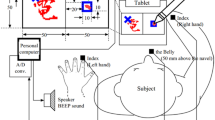Abstract
The control of voluntary movements is a dual structure consisting of cognitive and physical controls; cognitive control involves attentional resources, unlike physical control. Various voluntary movements can be performed by combining cognitive and physical controls. Body movements depending on attentional resources are performed using cognitive control; these movements fluctuate with white noise and their fluctuations gradually become the one-over-f fluctuation as the dependence on the attentional resources decreases. The handwriting process of characters is a voluntary movement. This study focused on the relationship between the repetitive handwriting process and the attentional resources allocated to it. The attention resources allocated to the handwriting process depend on the difficulty of the handwriting task. Moreover, the difficulty of a handwriting task is determined by the complexity of the shape of the handwritten characters, and the stroke counts is one indicator of this. Therefore, we focused on five Chinese kanji characters with different stroke counts. We investigated fluctuations in the temporal and spatial handwriting elements (twelve handwriting elements in all) defined within the handwriting process of each Chinese kanji character. The detrended fluctuation analysis was applied to the fluctuation analysis of the handwriting elements. In this paper, we discussed the relationship between the handwriting task difficulties and handwriting elements using local scaling indices based on the detrended fluctuation analysis.







Similar content being viewed by others
References
Miyake Y, Onishi Y, Pppel E (2007) Two types of anticipatory-timing mechanism in synchronization tapping. In: Object recognition, attention, and action. Springer, Berlin, pp 231–244
Komatsu T, Miyake Y (2005) Time evolution of asynchronous value in synchronization tapping task (in Japanese). SICE 41(6):518–526
Maleki A, Oshima Y, Nozawa A, Mizuno T, Uchida M (2015) Analysis of fluctuation in repeated handwriting based on psychophysiological factors. In: 7th International conference on unsolved problems on noise, p 21
Kumagai R, Uchida M (2017) Detrended fluctuation analysis of repetitive handwriting. In: 2017 International conference on noise and fluctuations, pp 350–353
Mandelbrot BB, Wallis JR (1969) Some long-run properties of geophysical records. Water Resour Res 5(2):321–340
Hardstone R, Poil S-S, Schiavone G, Jansen R, Nikulin V, Mansvelder HD, Linkenkaer-Hansen K (2012) Detrended fluctuation analysis: a scale-free view on neuronal oscillations. Front Physiol 3(450):1–13
Peng CK, Havlin S, Stanley HE, Goldberger AL (1995) Quantification of scaling exponents and crossover phenomena in nonstationary heartbeat time series. CHAOS 5(1):82–87
Bryce RM, Sprague KB (2012) Revisiting detrended fluctuation analysis. Sci Rep. https://doi.org/10.1038/srep00315
Kumagai R, Uchida M (2018) Fluctuation analysis of synchronous repetitive handwriting. In: 8th International conference on unsolved problems on noise. Book of Abstracts UPoN, p 130
Uchida M (2019) Fluctuation analysis of repetitive writing motion by using DFA. In: 2019 International conference on noise and fluctuations. ICNF Proceedings, pp 112–115
Tanaka K, Arai K, Uchida M (2019) Evaluation of task difficulty based on fluctuation characteristics in writing task. Artif Life Robot 25:17–23. https://doi.org/10.1007/s10015-019-00570-w
Curran SL, Andrykowski MA, Studts JL (1995) Short form of the profile of mood states (POMS-SF): psychometric information. Psychol Assess 7(1):80–83
Spielberger Charles D, Gorsuch Richard L, Lushene Robert E (1970) STAI manual for the state-trait anxiety inventory (self-evaluation questionnaire). Consulting Psychologists Press, Mountain View
Acknowledgements
This work was supported by JSPS KAKENHI Grant-in-Aid for Scientific Research (C) Number 17K00477. The authors would like to thank Enago (http://www.enago.jp) for the English language review.
Author information
Authors and Affiliations
Corresponding author
Additional information
Publisher's Note
Springer Nature remains neutral with regard to jurisdictional claims in published maps and institutional affiliations.
This work was presented in part at the 25th International Symposium on Artificial Life and Robotics (Beppu, Oita, January 22–24, 2020).
About this article
Cite this article
Tanaka, K., Uchida, M. Evaluation of handwriting task difficulty based on detrended fluctuation analysis. Artif Life Robotics 26, 169–175 (2021). https://doi.org/10.1007/s10015-020-00672-w
Received:
Accepted:
Published:
Issue Date:
DOI: https://doi.org/10.1007/s10015-020-00672-w




